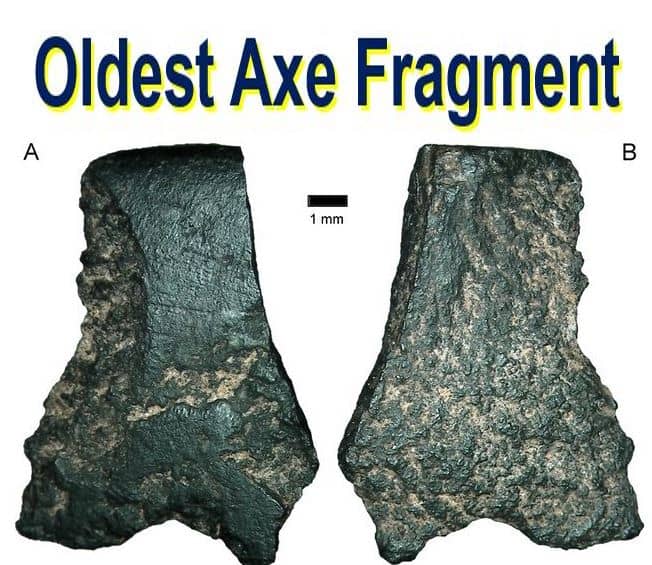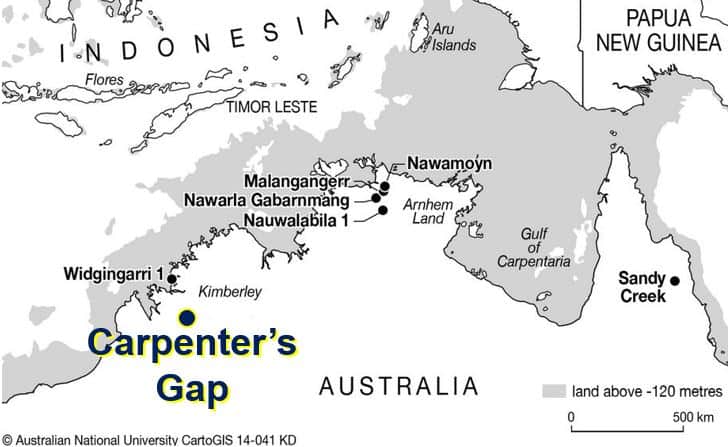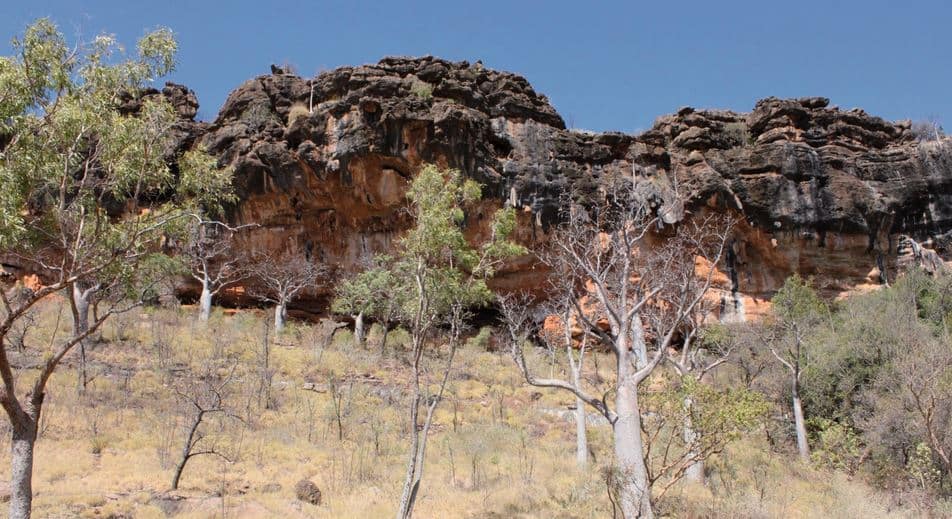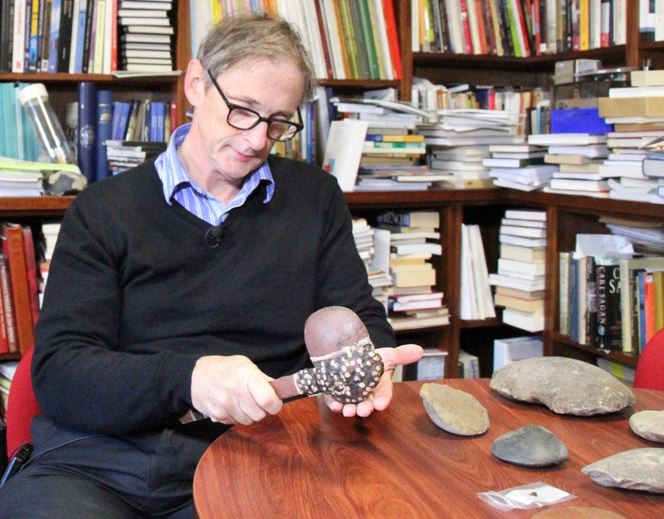The oldest axe we know about, a fragment of it, between 45,000 and 49,000 years old, has been discovered by a team of archaeologists in the remote Kimberley region of Western Australia. The scientists say their discovery shows that the first Australians were technological innovators.
The axe fragment, which is no larger than a thumbnail, dates back to when humans first arrived on the Australian mainland. It is estimated to be at least ten thousand years older than any other previously-discovered axe.
Professor Peter Hiscock, Tom Austen Brown Chair of Australian Archaeology at the University of Sydney, and colleagues wrote about this latest find in the academic journal Australian Archaeology (citation below).
 Microscope’s view of the world’s oldest axe fragment – it is the size of a thumbnail. (Image: sydney.edu.au. Credit: Australian Archaeology)
Microscope’s view of the world’s oldest axe fragment – it is the size of a thumbnail. (Image: sydney.edu.au. Credit: Australian Archaeology)
Humans adapted when they arrived in Australia
Prof. Hiscock said:
“Since there are no known axes in Southeast Asia during the Ice Age, this discovery shows us that when humans arrived in Australia they began to experiment with new technologies, inventing ways to exploit the resources they encountered in the new Australian landscape.”
The axe fragment was first unearthed in the early 1990s by Professor Sue O’Connor from the Australian National University, among a sequence of artwork, food scraps, tools, and other artifacts from Carpenter’s Gap, a large rock shelter believed to be one of the earliest sites occupied by humans.
Prof. O’Connor said:
“Nowhere else in the world do you get axes at this date. In Japan such axes appear about 35,000 years ago. But in most countries in the world they arrive with agriculture after 10,000 years ago.”
 A map of northern Australia in its regional setting, showing the location of Carpenter’s Gap (where the axe fragment was found) and other sites with Pleistocene axes. (Image: Australian Archaeology)
A map of northern Australia in its regional setting, showing the location of Carpenter’s Gap (where the axe fragment was found) and other sites with Pleistocene axes. (Image: Australian Archaeology)
Two years ago, as a further study was underway – examining the objects that had been unearthed at the site – Prof. Hiscock and colleagues discovered a small fragment of a polished axe that had been recovered from the oldest levels of the excavation site.
After carefully examining the fragment, scientists said that it came from an axe that had been shaped from basalt, then polished by grinding it on another rock until it was smooth.
The fragment originated from the polished edge, when it was later sharpened again. The archaeologists believe the axe was probably carried away to be used somewhere else, leaving the fragment behind.
Polished stone axes vital tools for hunter-gatherers
Regarding tools and weapons used by hunter-gatherer societies, Prof. Hiscock said:
“Polished stone axes were crucial tools in hunter-gatherer societies and were once the defining characteristic of the Neolithic phase of human life.”
“But when were axes invented? This question has been pursued for decades, since archaeologists discovered that in Australia axes were older than in many other places. Now we have a discovery that appears to answer the question.”
 Carpenter’s Gap, a photograph of the shelter. (Image: Australian Archaeology)
Carpenter’s Gap, a photograph of the shelter. (Image: Australian Archaeology)
The authors say evidence points to the technology being developed in Australia after humans arrived approximately 50,000 years ago.
Prof. O’Connor said:
“We know that they didn’t have axes where they came from. There are no axes in the islands to our north. They arrived in Australia and innovated axes.”
The scientists say that the ground-edge axe technology specifically emerged as dispersing humans adapted to their new regional environments.
 Professor Peter Hiscock holding a hafted axe, indicative of the kind the discovered fragment came from. (Image: sydney.edu.au)
Professor Peter Hiscock holding a hafted axe, indicative of the kind the discovered fragment came from. (Image: sydney.edu.au)
Prof. Hiscock said:
“Although humans spread across Australia, axe technology did not spread with them. Axes were only made in the tropical north, perhaps suggesting two different colonizing groups or that the technology was abandoned as people spread into desert and sub-topical woodlands.”
“These differences between northern Australia, where axes were always used, and southern Australia, where they were not, originated around the time of colonization and persisted until the last few thousand years when axes began to be made in most southern parts of mainland Australia.”
In an Abstract in the journal, the authors wrote:
“Ground-edge axes are now known from two different colonised lands at the time humans arrived and hence we argue that these technological strategies are associated with the adaptation of economies and social practices to new environmental contexts.”
A significant announcement
The announcement of the find is significant, Prof. Hiscock wrote in The Conversation. It reveals cultural and technological novelty and innovation in the modern humans who dispersed from Africa.
Prof. Hiscock wrote:
“We have had a lot of press coverage today. Much of it good, much of it fair. And there have been some criticisms.”
American archaeologist John Shea was quoted by the BBC as saying:
“The evidence is essentially one flake – one piece of stone out of hundreds and hundreds that they’ve excavated from this rock shelter site […] They would make a stronger case if they could show that similar chips with edge abrasion occurred at a greater number of sites.”
Citation: “World’s earliest ground-edge axe production coincides with human colonisation of Australia,” Peter Hiscock, Sue O’Connor, Jane Balme & Tim Maloney. Australian Archaeology. 7 May 2016. DOI: 10.1080/03122417.2016.1164379.
Video – Oldest axe fragment found in Western Australia
Archaeologists in Australia found a fragment of the world’s oldest axe in the remote Kimberley region.
